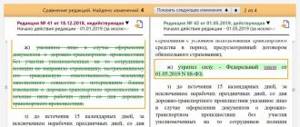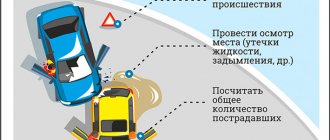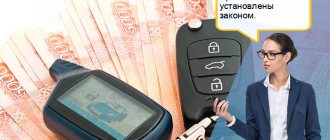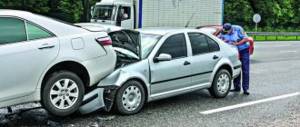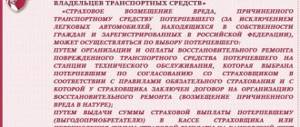In the event of an accident, the compulsory motor liability insurance policy must protect the culprit of the accident from financial losses and guarantee the injured driver compensation for damages. Practice, including judicial practice, shows that this is not so; previously, the compulsory motor liability insurance policy protected only the culprit of the accident, not allowing the victim to receive full compensation for damage, and on March 10, 2021, the Constitutional Court of the Russian Federation issued Resolution No. 6-P, which amends procedure for compensation of losses in case of accidents, now the law on compulsory motor liability insurance is not only not aimed at protecting the interests of the victim in an accident, but protects exclusively the interests of insurance companies!
What changed?
Within the framework of compulsory motor liability insurance, damage sustained in an accident was assessed taking into account the wear of components (with the exception of certain groups). The amount calculated by the insurer usually did not cover all the costs of repairing the car. If, during the assessment, it turned out that the repairs would cost an amount that exceeds the compensation limit under compulsory motor liability insurance, the difference was recovered from the culprit of the accident. The wear and tear of spare parts was also taken into account and the victim was forced to look for used spare parts to repair his car.
In March 2017, the Constitutional Court ruled that when recovering damages from the driver responsible for an accident, the degree of wear and tear of components should not be taken into account. The compensation amount includes the cost of new spare parts and actual expenses incurred. In this case, the insurer compensates for the damage as before, calculating the amount of payment according to the Unified Methodology (should be read “according to the curved RSA reference books”) and also taking into account the degree of wear and tear.
The consequences of this decision of the Constitutional Court are clearly negative for all participants in the accident, except for insurers:
- The burden of compensation for losses falls to a greater extent on the culprit of the accident (whose motor vehicle liability should be protected by a compulsory motor liability insurance policy). The insurance company compensates for damage according to the Unified Methodology of the Central Bank of the Russian Federation, taking into account the wear and tear of components (with a cash payment). In case of in-kind compensation, the compensation limit under MTPL continues to apply. If the car owner injured in an accident is not satisfied, he cannot make financial claims to the insurer, but is forced to contact the person responsible for the accident, without taking into account the wear and tear of components. For example, if a 20-year-old foreign car has a rusty fender that needs to be replaced, the defendant will have to pay the cost of a new body part;
- For injured drivers, obtaining compensation becomes more difficult. You can only demand compensation for damages from the person responsible for the accident through the court. Financial claims must be justified by assessing the damage and calculating the cost of restoration repairs. Even if the court rules in favor of the plaintiff, there is no guarantee that the victim will receive compensation—enforcement proceedings can drag on for years.
○ Who calculates wear and tear and how?
Calculating the wear and tear of a specific part of a vehicle, as well as conducting an examination of the cost of restoration repairs, is possible only by a specialized organization (as well as an individual expert) that has the appropriate permit to carry out this type of work.
If there is a legal dispute, the judge himself appoints a person who will carry out this calculation (taking into account the specified requirements), then such a person will be called a forensic expert. The wear of car parts is influenced by various factors, including:
- Mileage (according to odometer readings).
- Service life of a specific part.
- Carrying out repair work or replacing a spare part with a new one.
- Technical parameters of the part (for example, continuous corrosion).
- Quality of repairs (if any were ever carried out).
- The date the car left the assembly line.
- Vehicle category.
- Car make, etc.
The calculation of wear and tear must be made by an expert taking into account the requirements of the stated regulatory legal act of the Bank of Russia, methodological recommendations for forensic experts in this field of knowledge and other official studies and recommendations.
The necessary calculations must be carried out in accordance with the formulas approved by the legal act of the Central Bank. They are different for vehicle parts, assemblies, assemblies and tires.
Clause 4.1 Provisions:
- “Wear of components (parts, assemblies, assemblies) is calculated using the following formula:
- Iki = 100 x (1 – e-(∆TxTki ∆LxLki)),
- where: Iki – wear of a component (part, assembly, unit) (percent);
- e – base of natural logarithms (e≈2.72);
- ∆T is a coefficient that takes into account the influence of its service life on the wear of a component (part, assembly, unit);
- Tki – service life of a component product (part, assembly, unit) (years);
- ∆L is a coefficient that takes into account the influence on the wear of a component (part, assembly, unit) of the mileage of the vehicle with this component;
- Lki – vehicle mileage as of the date of the traffic accident (thousands of kilometers).”
The coefficients from the formula are taken on the basis of Appendix 5 of the specified legal act and depend on the make of the vehicle and the category to which it belongs (B, C, etc.). Other data is contained in the technical documentation of the car and on its instruments (odometer).
Due to the fact that this formula cannot take into account some individual characteristics of a particular periphery, the possibility of accruing so-called individual wear and tear (formed, for example, as a result of unskilled repairs) is provided.
Clause 4.5 Provisions:
- “Ish=(Nn-Nf)/(Nn-Ndop)*100%,
- where: Ish – tire wear (percent);
- Нн – height of the tread pattern of the new tire (millimeters);
- Нф – actual height of the tire tread pattern (millimeters);
- Ndop – the minimum permissible height of the tire tread pattern in accordance with the requirements of the legislation of the Russian Federation (millimeters).”
At the same time, the indicator of the manufacturing period of this element is also taken into account: for 3-5 years, wear should be increased by 15%, and for tires older than five years, an additional 25% of wear is charged.
Where does the Constitutional Court resolution of March 10, 2017 apply?
Insurance companies began to use this regulation in droves. If a car insured under CASCO is damaged in an accident, then insurers forget about recent savings, show loyalty to their policyholder, and with unprecedented ease send such cars, regardless of their age, to dealerships. Where they are repaired at inflated (compared to regular service stations) prices. And after some time, they bring a claim against the culprit of the accident*, demanding additional payment of the difference between the payment under compulsory motor liability insurance and the actual repair, even if the damage does not exceed the insurance company’s payment limit.
Let's give an example: the damaged Toyota Land Cruiser 200, manufactured in 2014, is insured under CASCO and received damage in the form of a broken front bumper, which needs to be replaced. Repairs at a dealer station will cost approximately 45 thousand rubles. The cost of the bumper at the dealer is about 33 thousand and the replacement and painting work is about 12 thousand. The compensation payment under compulsory motor liability insurance will be approximately 11-12 thousand rubles. Bumper according to the RSA directory - 6 thousand rubles (minus wear - 30-40 percent), 4 thousand rubles remain, replacement and painting work according to the Unified Methodology is approximately 7 thousand rubles. This means the culprit must pay extra. Attention!!! 45-11=34 thousand rubles! And most importantly - everything is according to the law!!!
A reasonable question arises: Why is such insurance needed?
At the moment, we are not able to answer it.
Calculation of physical wear and tear taking into account the age and mileage of the vehicle from the beginning of operation.
It is necessary to assess the physical wear and tear of a passenger car, the actual age of which is 11 years, the actual mileage since the start of operation is 198 thousand km.
Let's determine physical wear and tear using the formula:
Where:
Let's determine the value of Ω: Ω = 0.07 * Tf + 0.0035 * Lf
Then If=100*(1 – e^-1.463) = 76.8%
Assessment of the physical wear and tear of a car using the weighted average age method.
Car 2102, 1974, its cost in new condition is 97,920 rubles. In 1990, the body was replaced, which costs 78,300 rubles. In 2000, a new gearbox was supplied at a cost of 6,000 rubles. It is necessary to determine the amount of physical wear and tear. The standard wear rate per year is 5%. All prices are current.
| date | Age (years) | Cost, rub.) |
Let's determine the weighted average age of the car:
(30*97920+14*78300+4*6000)/(97920+78300+6000) = 22.2 years
Let's determine the amount of physical wear and tear:
Thus, we see that the car is more than 100% worn out.
Obsolescence assessment
The car was produced in 1993, discontinued in 2000. The production of spare parts was discontinued in 2003. The car was in an accident 2 times and had 1 owner.
We determine the obsolescence of a vehicle:
1. The period from the date of removal of the vehicle from production until the date of assessment is 4 years, therefore, 4 * 2 = 8%
2. Because production of spare parts is discontinued, then 20%
3. For each accident – 5%, therefore, 5*2 = 10%
4. Because The car had one owner, then this factor is not taken into account when determining obsolescence.
Thus, summing up the obtained indicators, we obtain obsolescence, which is equal to 38%.
Determination of accumulated wear.
Let's continue the previous example (the obsolescence of the car is 38%). Let's say the physical depreciation of this vehicle was estimated at 53%. Then we determine the accumulated wear and tear of the car:
In = [1 – (1 – If)*(1 – Iffunction)]
Conclusion
In the course of this study, the author came to the following conclusions:
· the cost of vehicles in the general case is a function of many factors, which can be divided into two groups: intra-object (intra-system) and external-object (extra-system);
· wear and tear is an actual loss in the value of a vehicle as a result of a set of factors leading to deterioration or loss of consumer properties of vehicles;
· depending on the reasons causing the depreciation of the vehicle, the following types of wear and tear are distinguished: physical, functional (moral), external (economic);
· when assessing vehicles, two types of wear and tear are used - physical and moral;
· establishing the degree of physical wear and tear is necessary to determine the real residual value and plan the replacement of out-of-service vehicles with new ones;
How to act correctly?
If you are not at fault for the accident. The procedure is standard: after an accident, you need to contact the insurance company, assess the damage, and receive compensation. If the compensation does not cover the actual costs of repairs, evidence of this will be needed (an estimate of the actual damage, documents from the insurance company, etc.). Financial claims must be adequate. If the amount of damage claimed by the plaintiff is greater than the cost of the entire car (if we are talking about an old car, for example), the claim will most likely be denied.
If you are at fault in an accident. It is advisable to record the actual damage to the second car (take a photo at the scene of the accident). If, when compensating for damage by the insurer, the amount of compensation was less than the limit provided for by compulsory motor liability insurance, the insurer is brought in as a co-defendant. The defendant may also offer his own methods of compensation for the damage caused, for example, full-scale repair of the damaged car. This should be used if the financial claims are greatly inflated, and for an old foreign car the plaintiff demands, for example, repairs at a dealership.
carries out assessments of damage caused to cars in road accidents, we employ auto lawyers, we effectively protect the financial and legal interests of car owners.
How to calculate car depreciation
There are several methods in accounting; the choice depends on the class of the car, the purpose of its use, and the terms of the contract. The simplest and most frequently used is linear. It uses the following formulas:
For example, let's take a car with an initial cost of 600,000 rubles. The useful life period is 5 years.
This formula is used not only for accounting calculations. Suppose you are a taxi driver, you bought the car from the example above and want to calculate how much you need to earn per month so that the car, without taking into account the costs of its maintenance, will pay off in five years.
Take the resulting depreciation value and divide it by the number of working months. Let there be 11 of them, and 1 is a vacation. 120,000/11=10,909 rubles per month.
When making calculations for MTPL, in banks, car pawnshops, and trade-in companies, a different formula is used:
Physical wear and tear of the car = (I1xPf+I2xDf)xA2xA3xA4
They use data about your car, the climate in which you live, the intensity of use of the car, and the number of residents in the region.
Car depreciation calculation
Let's assume we buy a passenger car produced in 2012, with an engine capacity of 1.4 liters, dimensions from 3.6 to 3.9 m, mileage of 75,364 km in Barnaul. New cars of this brand cost 600,000 rubles, the seller set a price of 450,000 rubles.
Is it a lot or a little? Let's look at the table of zoning according to the climatic conditions of the regions of the Russian Federation - the Altai Territory belongs to a cold climate.
Environmental aggressiveness is high (85 kg of atmospheric emissions per inhabitant). The number of residents in the region is 700 thousand.
Let's calculate the average annual mileage. 75,364/5=15072.8 km/year. This value corresponds to coefficient I2=0.89
Let's calculate the value ourselves:
We got the value of normal wear and tear. Let's calculate it in money:
600,000x43.6/100=261,600
The cost of the car for 2021 will be 600,000-261,600=338,400.
Now you know how to calculate the depreciation of a car and can use the data obtained when bargaining.
Calculation of depreciation per 1 km of run
In addition to the loss in value due to wear and tear, the car requires maintenance costs. To calculate depreciation per 1 km, we need the following data:
The price of fuel per 1 km is calculated using the formula: consumption/100*price of 1 liter. Divide the prices from points 3,4,5,6 by the number of kilometers from point 2. Add the resulting values, you get the cost of 1 km of your car.
Source
Is it legal to recover the difference in payment under compulsory motor liability insurance from the culprit?
Important! Didn't receive an answer to your question? Our expert lawyers work for you. It's absolutely free!
- Only practicing traffic lawyers
- Anonymously
- For free
or call toll free number 8
✖
Alas, yes. The Constitutional Court ultimately upheld the complaint of those who applied and issued a corresponding ruling.
But what is the logic? And what happens if you are the culprit of an accident, then the insurance company will only cover part of the losses? That is, the insurance law works in such a way that the culprit in any case will have to compensate for the damage himself, albeit partially? Absolutely right.
Before the ruling of the Constitutional Court, judicial practice worked uniformly. The judges believed that the harm compensated by the insurance company in the form of payment or repairs was fully compensated, even if the victim did not have enough money for the actual repairs. There is nothing to demand from the culprit, because his liability is insured.
But the Constitutional Court did not agree with such judicial practice. And here's the thing!
You can provide a number of links to articles of legislation in force for 2021, but in our case, only one article is sufficient - 1072 of the Civil Code of the Russian Federation:
Civil Code of the Russian Federation Article 1072. Compensation for damage by the person who insured his liability. A legal entity or citizen who has insured its liability through voluntary or compulsory insurance in favor of the victim (Article 931, paragraph 1 of Article 935), in the event that the insurance compensation is not enough to fully compensate for the damage caused, compensates the difference between the insurance compensation and the actual the amount of damage.
In the context of this particular rule of law, the Constitutional Court explained that since the Constitution of the Russian Federation gives a citizen the right to private property, this right cannot be violated by incomplete payment. And Article 1072 of the Civil Code gives the right to recover the difference in payment without depreciation under OSAGO directly from the culprit.
Judicial practice: read the relevant resolution of the Constitutional Court of the Russian Federation.
Exception - European protocol
All of the above works only in cases where the accident is registered with traffic police officers. The European Protocol establishes its own rules for damage compensation. And, according to them, by signing the European protocol notice, the victim agrees with the fact of compensation for damage within the limits of the insured amount.
The legislative argument here is Resolution of the Plenum of the Supreme Court of the Russian Federation No. 2 dated January 29, 2015, which says the following:
39. Compensation for losses within the amounts established by Article 11.1 of the Law on Compulsory Motor Liability Insurance is a simplified way of fulfilling obligations by the insurer, as a result of which payment of direct compensation terminates the obligation of the insurer and the causer of harm for a specific insured event (clause 1 of Article 408 - Civil Code of the Russian Federation). In this regard, the claim of the victim against the insurer and/or the causer of harm for damages in an amount exceeding the maximum amount of insurance payment within the framework of the simplified procedure for registering a road traffic accident is not subject to satisfaction, except in cases where the agreement of the participants in the road traffic accident on its registration without the participation of authorized police officers was declared invalid by the court.
In fact, the first paragraph of the quote tells us that even if, together with the difference between the calculation without wear and tear and the paid insurance amount with wear and tear, it does not exceed the limit under the European protocol, then it is impossible to directly recover payment without wear and tear from the culprit. But the second paragraph directly indicates only cases where the actual amount of damage exceeds the limit under the European protocol.
If the victim applies for Casco
Let's look at a simple example. An accident occurred, and the victim decided to repair the car under Casco, rather than immediately apply through compulsory motor liability insurance. In this case, the insurance company of the culprit under compulsory motor liability insurance, within the framework of subrogation, pays the amount of the insurance victim, which insured him under Casco. But the point is that OSAGO again pays the amount with wear and tear. And under Casco, the victim was repaired without taking into account wear and tear (most often, Casco agreements do not provide for wear and tear).
And in this case, the victim’s insurance company has the right to directly recover the difference between the calculation without wear and tear and with wear directly from the culprit. Simply, the right of claim in this case passed from the victim to his insurance company.
Which details are taken into account and which are not?
As you know, for the restoration of a vehicle, you may need many spare parts, components and assemblies, including materials for body work, etc.
Of course, it is necessary to take into account the fact that insurance companies cannot afford to pay the full cost of damaged parts, since at the time of the car accident the car may no longer be new. Consequently, a percentage is calculated, namely the wear and tear of car parts, and is paid only as part of the required amount.
Despite the fact that when worn out under compulsory motor liability insurance, taking into account the coefficients, victims do not receive full compensation, there are some parts that are installed new at full cost.
So, such parts for which wear is not taken into account are:
- Devices for driver safety: airbag, belt, child restraint;
- Brake system and its elements;
- Units responsible for steering.
Thus, if the wear percentage is not determined for these spare parts, then the insurance company pays their full cost. But it is worth noting that parts without wear under MTPL, or rather their cost, may go beyond the maximum amount of compensation paid by the insurance company. In this case, the innocent driver whose car is being restored will be forced to pay extra himself or oblige the initiator of the accident to do so.


